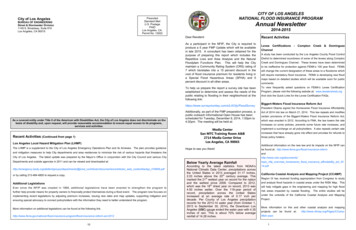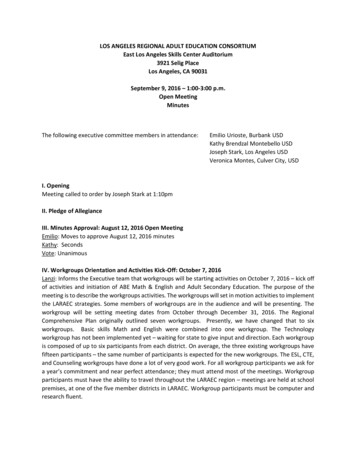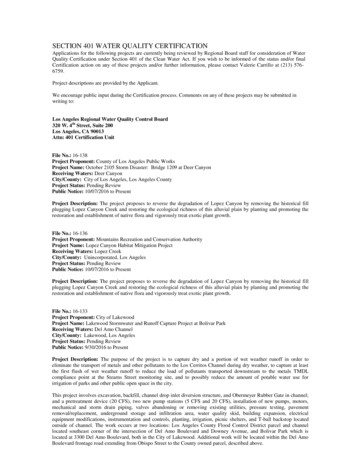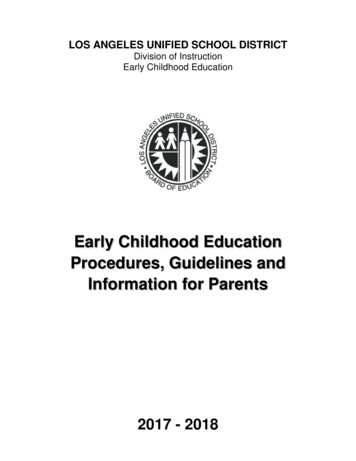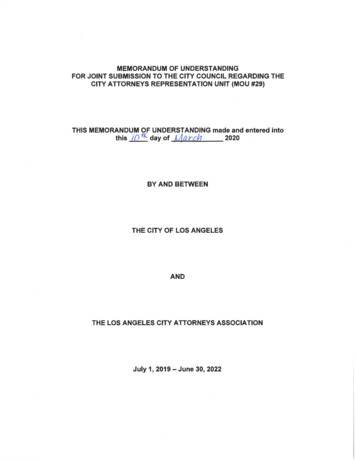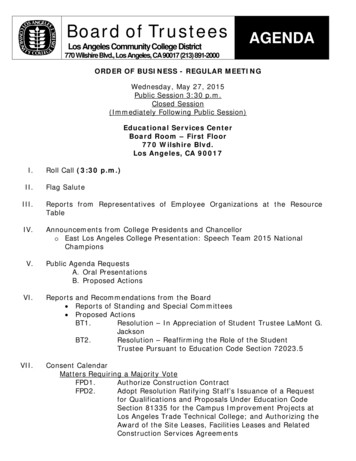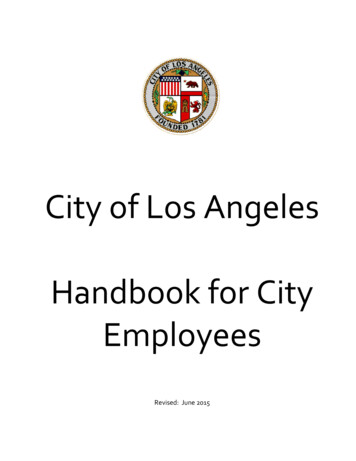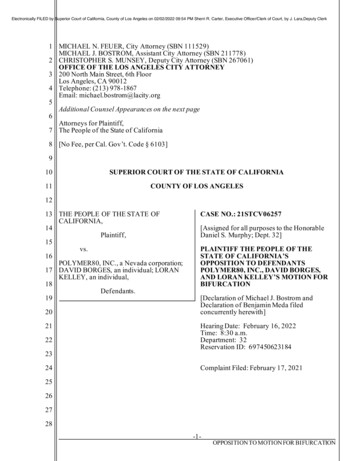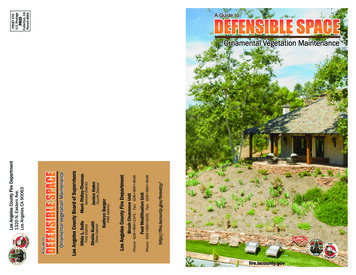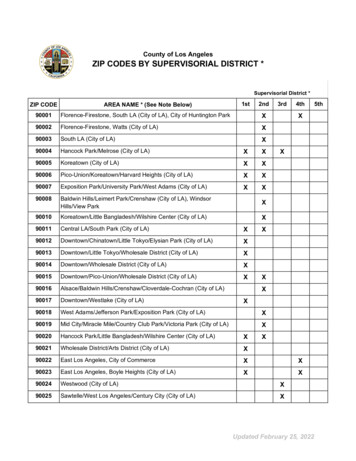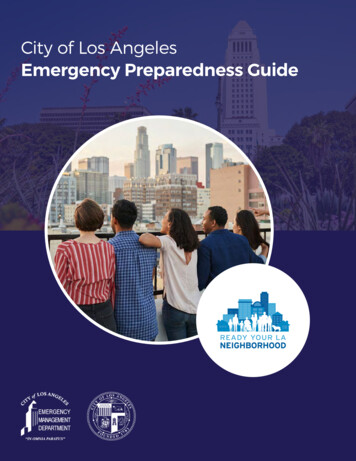
Transcription
City of Los AngelesEmergency Preparedness Guide
Table of Contents . . . . . . . . . . . . . . . . . . . . . . . . . . . . . . .2 Make Your Plan and Practice . . . . . . . . . . . . . . . 6 . . . . . . . . . . . . . . . . . . . . . . . . . . . . . . . .4 Stay Informed . . . . . . . . . . . . . . . . . . . . . . . . . . . . 175 Get Involved . . . . . . . . . . . . . . . . . . . . . . . . . . . . . . 216 What to Do During a Disaster . . . . . . . . . . . . 26Earthquake . . . . . . . . . . . . . . . . . . . . . . . . . . . . . . . 26Fire . . . . . . . . . . . . . . . . . . . . . . . . . . . . . . . . . . . . . 30Active Shooter . . . . . . . . . . . . . . . . . . . . . . . . . . . . . 32Tsunami . . . . . . . . . . . . . . . . . . . . . . . . . . . . . . . . . . 34 . . . . . . . . . . . . . . . . . . . . . . . . . . . . . . .Communication Plan . . . . . . . . . . . . . . . . . . . . . . . . . 40Important Documents Checklist . . . . . . . . . . . . . . . . . 42Disaster Supply Kit . . . . . . . . . . . . . . . . . . . . . . . . . . 42Grab-and-Go Kit . . . . . . . . . . . . . . . . . . . . . . . . . . . . 43Commuter Kit . . . . . . . . . . . . . . . . . . . . . . . . . . . . . . 43Under the Bed Kit . . . . . . . . . . . . . . . . . . . . . . . . . . 44Workplace Kit . . . . . . . . . . . . . . . . . . . . . . . . . . . . . . 44Pet Preparedness . . . . . . . . . . . . . . . . . . . . . . . . . . . 45
About this GuideThis Emergency Preparedness Guide has been provided by the City of Los Angeles EmergencyManagement Department (EMD) as part of the city’s Ready Your LA Neighborhood (RYLAN)program . This quick reference guide provides the information needed to help you and yourfamily learn the importance of being prepared and how to prepare for disasters before theyhappen . Los Angeles is at risk from natural, man-made, and accidental incidents of high consequence . Understanding and preparing for the threats facing our city is a shared responsibility . Take some time to read it and share what you learn with your family and friends . This is afree publication, available online and in hardcopy (limited quantities) .About the City of Los AngelesEmergency Management DepartmentThe Emergency Management Department (EMD), established by City Ordinance in 2000,leads the City of Los Angeles in comprehensive emergency management, including planningfor, response to, recovery from, natural, man-made, and accidental incidents of high consequence . The EMD is one of the City’s public safety agencies whose job is to plan for howthe local government and its communities and businesses will respond to and recover fromdisasters . This is accomplished by writing emergency plans, training and exercising themwith departments who will be involved in helping the city get back to normal following alocalized or citywide disaster . Additionally, we focus on creating a culture where neighbors,businesses, and communities work together to prepare in advance of a disaster and learnthe best steps to take in the immediate aftermath, so that everyone in our city can recoverquickly and emerge stronger as a more prepared community .EMD also works with numerous municipalities, state and federal agencies, and the privatesector to preserve life, stabilize and resolve incidents, limit loss, conserve property, and ensurecontinuity of operations and government . The department is involved with a number of outreach, educational, and community preparedness activities, such as RYLAN, that make readiness for all Angelenos a priority .—3—
Ready Your LA NeighborhoodWelcome to the City of Los Angeles Emergency Management Department (EMD)Ready Your LA Neighborhood (RYLAN) Program . RYLAN is designed to help you, your family,and your neighborhood prepare for disasters . Here are a variety of important actionsyou can take to increase your readiness .For more information, visit us at ReadyLA orgPrepareOrganizePracticePreparing yourself, family,and your neighborhoodreduces the seriousimpacts of disaster .Prepare for emergenciesthat can occur at home,work, or in transit . Manyactivities are free of costand take only minutes .Host a Map YourNeighborhood (MYN)meeting* . You and yourneighbors will create aresponse plan . You willlearn what to do in thefirst hour of a disaster,when the most lives andproperty can be saved .Disasters can overwhelmthe capacity of 9-1-1 .Neighbors become yourbest source of help . Yourconfidence as responderswill increase as you practice using your neighborhood response plan .*Virtual or in-personoptions available.ConnectCommunicateLearnSign up for the City’semergency notificationprogram, Notify LAWhen disasters occur, theCity will alert you withspecific instructions onwhat to do . Text READYto 888-777 to sign up .You can also follow EMDon social media at@ReadyLA .Create and practice apersonal communicationplan that includes local,out of state, and otherimportant emergencycontacts .Enroll in FREE preparedness training classesoffered by our partneragencies, such as FirstAid, CPR, AmateurRadio, Active ShooterSurvival, Stop the Bleed,Community EmergencyResponse Team training,etc . to enhance yourreadiness skills .—4—
1IntroductionAre you prepared for a major earthquake, fire, flood or other disaster?This guide is designed to help you and your family get ready.This guide is provided as part of the RYLAN—Ready Your Los Angeles Neighborhood—Program, a free service offered by the City of Los Angeles Emergency ManagementDepartment to empower neighborhoods to be more prepared for the next big disaster .There are six components of the RYLAN Program: Prepare, Organize, Practice, Connect,Communicate and Learn . The information in this guide will focus on preparedness but providesinformation on other ways you can learn to organize, practice, connect, communicate and learn .Disasters often happen without warning, which is why it is so important to plan ahead .Planning can help save lives, reduce injuries and minimize damage .With preparation comes peace of mind .You will feel better knowing that in the event of a disaster you will be able to answerthese questions: Am I familiar with the types of disasters that can occur in my area? Do I know what to do during and after a disaster? How will I contact my loved ones if we are separated during a disaster? Do I have the right support network and emergency supplies to help me get by for up to14 days, if necessary?Preparing does not need to take a lot of time or money.This guide will walk you through the four steps of disaster preparation: MAKE YOUR PLAN and PRACTICE BUILD A KIT STAY INFORMED GET INVOLVEDThis guide will also explain how to plan for specific disaster situations and provide some helpfulsafety tips . In the back of the guide are easy-to-use checklists to help your preparation planning .—5—
2Make Your Planand PracticeEvery household needs to have a disaster preparedness plan. Why?Living in Los Angeles, we are vulnerable to a wide variety of disastersthat can happen without warning. Taking action today can help savelives, reduce injuries, and minimize damage. Planning ahead will alsohelp you be more mentally prepared to manage difficult events.Also, there is the potential that you may be separated from membersof your household when disaster strikes. They might be at work,school or the grocery store. By getting prepared, you can help notjust yourself, but also your family, friends, neighbors and community.Learning about HazardsLiving in Los Angeles means we are vulnerable to a wide variety of disasters . Most peopleknow about earthquakes but there are many other emergencies that can occur in the LosAngeles area such as wildfires, adverse weather, flooding, earthquakes, tsunamis, hazardousmaterials incidents, train wrecks, aircraft accidents, civil unrests, and others . The CaliforniaGovernor’s Office of Emergency Services has a great tool to help you understand the threatsin your area . http://myhazards.caloes.ca.gov/How to Start Your PlanOnce you understand the disasters that could happen in your area, the next step is to startpreparing . Gather with the members of your household and talk through various scenarios .Here are some key points to review:1. Determine the safest escape routes from your home, workplace and school including twoways out of each room .2. Identify safe spots in each room where you could take cover, if needed, like under sturdytables and desks .—6—
3. Identify family meeting places . Pick two locations – one in your neighborhood and anotheroutside of your neighborhood . In the event your home is unsafe, your family can meet atthe neighborhood location . In the event of an evacuation, meet at the location outsideyour neighborhood .4. Make an emergency contact list and include everyone’s phone numbers and additionalcontact information . Store all this information in your cell phone and make a few copiesfor your car, grab-and-go kit, and your house . Start a text message group with all of thesenumbers so you can communicate quickly . Use the Communication Plan at the backof the guide.5. Document emergency information you might need including medical information andinsurance for all family members . Use the Communication Plan at the back of the guide.6. Choose an out-of-state contact you can call after a disaster . Sometimes when phone linesare jammed it is easier to make an out of state call . All members of your household cancheck in with the out-of-state contact .7. If you are unable to place a phone call, try texting . Texting is more likely to succeed andalso leaves more phone lines open for 9-1-1 calls .8. Keep your important documents in a safe place and take them with you if you have toevacuate . Documents should be uploaded digitally to the cloud and hard-copies shouldbe stored in a fire-safe place like a safe or in a sealed plastic bag in the freezer . Use theImportant Documents Checklist at the back of the guide.Helping Children PrepareIf there are children in your household make sure you include them in the conversation andplanning process . Have age-appropriate conversations about disasters that could affect yourfamily and make sure kids know the family meeting locations . Plan in advance and notifyyour school or childcare who will pick upyour children in case you are unable to getthere . Also, ask your children’s school ordaycare about their emergency andevacuation plans .Make sure your childrenknow these three things!1. Their home address and familyphone numbers2. How and when to call 9-1-13. What to do if the smoke alarm or carbonmonoxide alarm goes offInclude children in the conversation—7—
Helping thosewith Access andFunctional NeedsPrepareIf there are members of your householdwho may need additional assistance, makesure you have what you need to assistthem with different types of disasters .Have a conversation with each person inyour household to clearly understand theirneeds . For those with mobility impairments,plan several accessible routes to get to yourplanned meeting places . If you or anyoneelse depends on power for medical equipment, make sure to plan for power outagesand have a backup battery power source .Consider storing back-up equipment, suchas a manual wheelchair, at a nearby accessible location . If anyone depends on dailymedications, talk to their medical providerabout obtaining an emergency supplyof medicine .Preparing forPets and ServiceAnimalsIf you have a pet or service animal, makesure to include them in your plan . Aim tohave a two week supply of food, along witha pet carrier for easy transportation and aphoto of you with your pet in case you areseparated and need to establish that youare the owner . Use the Pet PreparednessChecklist at the back of guide.Remember any animals in your household.—8—
Others Needing Additional SupportThere may be other individuals in your household who might need additional support orassistance during a disaster .Some of these people might be: Older Adults Non-Native English speakers Pregnant women or parents with babies and/or small children Homebound individuals Post-surgery patients People with physical or emotional disabilities Individuals with no access to transportation People with specific dietary needsSome questions to consider as you think about supportingthese members of your household: Have they documented their medical history and any medications they are taking? Is there anyone else who can help transport them if they are home alone when disaster hits? Can others in your Support Network help you and them? Can you help others in your Support Network?Practice, Practice, Practice!Once your family has created a plan, you should practice each component of it . Also, makesure everyone knows where your emergency kits and information are stored . It is recommendedthat you review and practice your plan annually .—9—
3Build A KitYour kit(s) will help you get through the days and weeks after adisaster. If possible, store two weeks of supplies but even a few dayscan be a big help. Store the kit someplace you will be able to get toin an emergency, even if your home is damaged.The main items to have in your disaster kit are water, food, medicalsupplies and equipment. Use the Disaster Supply Checklist at theback of the guide.WaterIdeally, store one gallon of water per person or pet, per day for 14 days (that’s 14 gallons perperson/pet) . If this is not realistic, store as much as you can . Use bottled water or put tapwater in clean plastic containers and try to store the water in a cool, dark place . It is recommended that you rotate your stock of water every 6 months . You can also use the water thatis already in your house or apartment’s plumbing and water heater . However, this should onlybe used as a last resort and not as a substitute for storing emergency water .Here is an explanation on how to access the water in your water heater .Access Reserves in the Water Heater Use extreme caution. Let the water cool.VENT Turn off cold water supply to the tank. Open the drain valve near the bottom.RELIEF VALVERemember: Some sediment at the bottom of the tank mayflow at first, continue to drain water until it becomes clear.Don’t forget to clean and sanitize your food and watercontainers before using them. Wash with soap and waterthen fill them with a 10% bleach unscented solution.After 5 min., empty the bleach solution and let air dry.Water that is dirty should be first strained through a coffeefilter, cheesecloth, or a paper towel to remove suspended matter.— 10 —TEMP CONTROLPILOT LIGHTACCESSWATER OUTLET
Sources of Drinking WaterIn an emergency, you can use water already in your water heater tank, plumbing, and inice cubes . Do not use water from the reservoir tank of your toilet . Access reserves in the water heater by opening the spigot at the bottom of the tank,attach a garden hose, and strain through a coffee filter or clean cloth . Before you access the water in your plumbing, locate the water inlet/shutoff valve foryour house, condominium or apartment and turn off the water . Pools, spas, waterbeds and similar sources of water can be used for sanitary purposesonly . Do not drink the water from these sources .Most utilities are only responsible for repairs to their meters . They will not be able torepair damages to your pipes or electrical wiring . However, repairs may be requiredbefore utility connection can be restored . Be patient and wait for the proper clearancesfrom the utility companies and health officials .Ratios for Purifying Water with BleachWATER QUANTITYBLEACH ADDED1 Quart4 Drops1 Gallon16 Drops5 Gallons1 TeaspoonAfter adding bleach, shake or stir the water container .Let stand 30 minutes before drinking .FoodWhen thinking about what food to put in your kit, foods that require no refrigeration and littlepreparation are best . Make sure to select foods that meet your family’s dietary needs and tastesand try to get nutritious food that your family will enjoy . Ready-to-eat canned meats, fruits andvegetables are good, and so are high-energy foods such as peanut butter, jelly, crackers andgranola bars . Once you have your disaster supplies ready, keep food in a dry and cool environment . It is recommended that you check the expiration dates every 6 months and replaceitems as necessary . Use the Disaster Supply Checklist at the back of the guide.— 11 —
Supplies/EquipmentThink about your day-to-day essential items, as well as which items you might need to helpyou recover from the disaster . For example, you should have a first aid kit to deal with minorinjuries and a portable radio to learn more about post-disaster conditions . You will also needthe items you use in daily life, such as medications and feminine hygiene products . Use theDisaster Supply Check List at the back of the guide for additional items.You should also have emergency kits in your workplace and car as well as smaller kits inspecific areas of your home:Grab-and-Go KitHave a bag ready with your essential items in case you have to evacuate quickly for suddenemergencies .Under-the-Bed KitHave a personal safety kit under your bed if disaster strikes while you are asleep . A hard hatto protect you from falling debris, sturdy shoes to protect your feet from broken glass, protective eyewear and masks for dust and debris particles, and work gloves to protect your handsfrom sharp objects .Commuter KitHave an emergency kit in your car or commuter bag that includes water, food, extra clothes,flashlight, phone chargers, sanitation supplies, and jumper cables (if applicable) .Workplace KitYou may have to shelter at your workplace for several hours to several days . Ensure you havesome food, water, warm clothes, and other essentials, at work, especially if you don’t use a carto get to work .Use the specified checklists at the back of the guide for each of these kits.— 12 —
Create kits for your home, workplace, and car Place smaller kits in specific locations in your home— 13 —
Getting your House ReadyMake sure everyone in your family knows the location of the smoke alarms, carbon monoxidedetectors, and fire extinguishers if you have them . It is also good to know where your utilities arelocated and how to shut them off . If you live in a multi-family residence such as an apartment orcondominium, learn your property management’s safety procedures for utility shut offs .Also, set a reminder to check your fire extinguishers, smoke alarms, and carbon monoxidedetectors twice a year . An easy way to remember this is to do it when you set your clocks fordaylight savings time .GASFIRE EXTINGUISHERSSMOKE ALARMSLearn the location of yourgas meter and how to shutoff the supply valve . DONOT shut off the gas supplyvalve unless yousmell or heargas leaking .Keep a fire extinguisherin plain view and on everyfloor of your home .Make sure to install smokealarms on every floor of thehouse, including the basement and in rooms wherepeople sleep .Carbon monoxide detectorsare vital because this gas istasteless and odorless .— 14 —
Home Inventory for an Insurance ClaimPrior documentation of all your belongings will be needed to file an insurance claim for possessions lost or damaged during a disaster . The California Department of Insurance has ahome inventory guide available at www.insurance.ca.govYou can also walk around your home and take a video recording of your possessions .Remember to open closets and drawers . Email a copy of the video to someone or yourself sothat there is a backup of your documentation .WATERAPPLIANCESFOODIf pipes are damaged, turnoff the main water valve .If appliances are wet, turnoff the electricity at themain fuse box or circuitbreaker . Then, unplug appliances and let them dry out .Throw out all food andother supplies that yoususpect may have beencontaminated or come intocontact with flood water .Have appliances checkedby an electrician beforeusing them again .Be alert that stored food andsupplies may shift and fall .Check with local authoritiesbefore using any water . Thewater could be contaminated . DO NOT flush toiletsuntil you know that sewagelines are intact .TIP: BROKEN WATERHEATER may leak carbonmonoxide . Always makesure your detectors areworking properly .— 15 —
Gas Shut OffElectricity Shut OffLOCATE GAS METER: Learn the locationof your gas meter and how to shut offthe supply valve. DO NOT shut off thegas supply valve unless you smell or heargas leaking. If you have “Natural Gas” (aline from the street) the main shut-offvalve is located next to your meter.ELECTRICAL PANEL: Know where yourelectrical panel is and which breakerscontrol power to your home. (Be aware ofsub panels in your garage or basement.)Remember DO NOT operate any electrical switches if a gas leak is suspected.TURN OFF GAS SUPPLY: Use a wrenchand carefully give it a quarter turn ineither direction so that the bar runscrosswise on the pipe. Shut off valvescovered with paint should be tappedgently to break the seal; forcing thevalve can break it. If you have propane(gas in a tank), turn off the main gassupply valve if it is safe to do so.BreakersTURN POWEROFF: Turn offindividual breakersFIRST, thenthe main switch .MeterTURN POWERON: Turn on themain switch FIRST,then the individualbreakers .OFFONValveto CloseOpenCloseWater Shut OffThe WATER SHUT OFF valve is foundwhere the water supply feeds thehouse . Check with your water companyto determine if a special tool is neededto turn the valve .A wrench may beused for multiplepurposes includinggas and watershut off.TIP: Walk carefully around yourproperty, look for downed powerwires, water or gas leaks, and damage to the structure(s). DO NOT enterseverely damaged buildings, especiallyalone. Wait for help and use safety gear.Open— 16 —Close
4Stay InformedIn the event of a disaster, you may receive different emergency notifications advising you to either leave or stay where you are. Here aresome key terms to understand.Evacuation Warning or VoluntaryEvacuationWhat it means: Prepare to leave your home and the area . Gather your family, pets, basicneeds, and important paperwork . Listen for instructions from emergency responders . If youhave special medical needs or limited mobility, you should prepare to leave the area whenan Evacuation Warning is issued . Those with horses or other large animals are encouraged toevacuate at this time as it may take longer to evacuate .Evacuation Order or Mandatory EvacuationWhat it means: This is a directive from the Police Department or Fire Department to leaveyour home or business immediately . Failure to evacuate may endanger the lives of others,and may result in your injury or death . Once you evacuate you will not be able to returnuntil the order has been lifted .EvacuationCenter/ShelterWhat it means: Evacuation Centers or Sheltersmay be set up by the City or partner agencies,such as the American Red Cross, if an areamust be evacuated for an extended amountof time . The location of the shelter will beannounced by local officials . EvacuationCenters are temporary points to gather andreceive information while evacuation sheltersprovide overnight lodging and meals .— 17 —Be ready to evacuate in the event of a disaster.
Shelter-In-PlaceLocal officials may order a Shelter-In-Place order if a hazard requires that people stay wherethey are . If a shelter-in-place order is issued, here are the steps you can follow:ListenShelterGo indoors immediately; either yourhome or the nearest building . Bringin pets without risk to yourself .Monitor KNX 1070AM or your localTV station for updates.Choose an inside room with as fewwindows and doors as possible .Wait for an all-clear and followinstructions from local emergencymanagement authorities.Vehicles: close windows and vents,and turn off air conditioning andheating . If driving, continue unlessofficials say otherwise .Refrain from using your phoneto keep lines free for emergencyresponders.If you are directed by authorities to seal off outside air, here iswhat you can do: Shut all doors and windows . Turn off heaters, air conditioners, ventilation fans, and close fireplace dampers . Cover your nose and mouth with a wet cloth . Seal windows with duct tape .— 18 —
Officials will use many different outlets to share informationand instructions .If there is a disaster that immediately threatens your safety the City will activate these systems:Alert SystemsIt is important to know how the City of Los Angeles will notify the community before,during and after an emergency . Here are some of the ways you can expect to findimportant emergency information:WIRELESS EMERGENCY ALERTS (WEA)During an emergency, alert and warning officials need to provide the public with life-savinginformation quickly . Wireless Emergency Alerts (WEAs), made available through the IntegratedPublic Alert and Warning System (IPAWS) infrastructure, are just one of the ways public safetyofficials can quickly and effectively alert and warn the public about serious emergencies .NOTIFY LAA Community Mass Notification System that will be used in emergencies to contact City residents and businesses through phonemessages, text messages and e-mail . Sign up at NotifyLA.orgCOMMERCIAL MEDIAListen or watch broadcast stations for regional emergency alert information for Los Angelesand the surrounding areas . Important information will be provided with Closed Captioning(CC) and/or with a sign language interpreter .AMATEUR RADIOThe City of Los Angele created the LAFD Auxiliary Communications Service (ACS) whichexpands and supplements emergency communications capabilities . ACS is recognizedas a state disaster group . More at www.LAFDACS.orgFREQ 147 3 110 9 (LAFD ACS CH 1)Websiteswww.NWS.NOAA.gov Sign up for weather-related web feeds that are sent directly bytext or email .www.LACounty.gov LA County updates after a disaster will list shelter locations and otheressential information .TIP: Remember that your car radio might be the easiest way to listen toemergency broadcasts .— 19 —
InformationAlert lertsKPCC 89.3 FMKFI 640 AMKCBS 93.1 FMKABC 790 AMKIIS 102.7 FMKNX 1070 AMfema.govSATELLITE RADIOSirius XM Channels:redcross.orgalertwildlife.orgFox News Ch.:fcc.govWireless EmergencyAlerts (WEA)CNN News Ch.:Smartphone AlertsFollow LAFD dispatches toStructure Fires, Brush Fires, CarAccidents and other emergencyactivities in real time.Smartphoneshave alerting appsfor emergencynotifications .These apps maywarn you of earthquakes, wild firesor other hazardousemergencies .Crime and safety alerts withreal-time updates includinguser-generated informationof incidents reported to 911.Sign Up for NotifyLANotifyLA is the City of Los Angeles’ mass notification system used to provide informationregarding necessary actions, such as evacuations, to Los Angeles residents, businesses andsubscribers via recorded phone messages, text messages or e-mail in case of emergencies orcritical situations . Alerts are targeted by geographic location . That means, alerts will only besent to the subscribers in the area impacted by the emergency .Register: www.notifyla.orgAnother way to stay informed is to follow EMD’s social media accounts including:Facebook: @ReadyLAInstagram: @ReadyLA— 20 —Twitter: @ReadyLA
5Get InvolvedWhen considering how to prepare for disasters, think about thepeople in your neighborhood and how you can work together. Thefirst people to assist in an emergency are often your neighbors,friends, family and co-workers. These individuals, not professional firstresponders, typically perform most rescues in major disasters. Thereare some great programs that can help you be better prepared.Ready Your LA Neighborhood (RYLAN)The City of Los Angeles has developed a free and simple awareness and training programcalled Ready Your LA Neighborhood (RYLAN) . This program helps your family and your neighborhood prepare for disasters . You and your neighbors will have an opportunity to create aplan together which will identify the steps to take immediately after a disaster to help youand your family stay safe . It provides the tools to prepare and organize your neighborhood torespond together in the first hours after a disaster to reduce injuries, protect property and theenvironment, and most importantly, to save lives . The RYLAN workshop can be conductedin-person or online . If you have any questions or would like to learn more, contact EMD .Prepare with your neighbors during a Ready Your LA Neighborhood Workshop— 21 —
ConnectPlanContact UsThe Golden HourRYLAN@LACITY.ORG, (213) 484-4800The first 60 minutes followingdisasters are proven to be the mostcrucial for saving lives, reducing theseverity of injuries, and decreasingproperty damage. EMD can help you choose a meetingdate and develop your meeting . You will work with EMD to identifyneighborhood boundaries so theycan prepare your meeting materials . EMD will provide free materials suchas the following:How Big Should MyNeighborhood Be? Meeting invitations Neighborhood Response Plans Experience shows the ideal size forneighborhoods is the number ofhouseholds you can check on in the“Golden Hour .” OK/Help Cards Maps of your neighborhood, floorplan, or contact informationspreadsheet You will work with EMD to identifyyour neighborhood boundaries .Invite Your Neig
outside of your neighborhood . In the event your home is unsafe, your family can meet at the neighborhood location . In the event of an evacuation, meet at the location outside your neighborhood . 4. Make an emergency contact list and include everyone's phone numbers and additional contact information .
